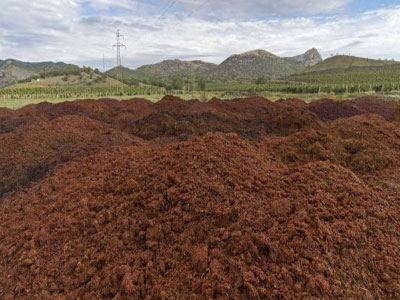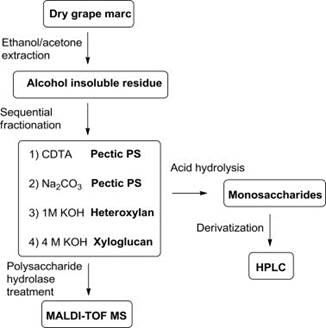


研究人员已经研发了从玉米秸秆和木纤维等纤维废料中提取生物燃料的方法,以便减少对环境的影响。最近发布在《生物资源技术》(Bioresource Technology)杂志上的一篇研究提供了一个很好的方向:将酒渣转化为生物燃料。来自澳洲阿德莱德大学的博士生 Kendall Corbin正尝试从酿酒废料中提取生物燃料。该研究发现,酿酒剩下的葡萄果渣中有31%-54%是由碳水化合物组成的,其中47〜80%可溶于水。葡萄果渣含有的丰富碳水化合物,很适合作为萃取生物燃料的原料。
Corbin还研究了如何用酸和酶提前处理葡萄果渣,提高提取生物燃料的有效性。
使用酸和酶提前处理后,1.1吨的葡萄果渣可转换成高达400升的生物乙醇。如果没有这些添加剂,大部分的葡萄果渣中发现的碳水化合物会直接通过发酵转化为乙醇,相同数量的葡萄果渣只能转化成270升的生物乙醇。
其余部分可作为肥料或动物饲料。(来源:生物360)
Grape marc as a source of carbohydrates for bioethanol: Chemical composition, pre-treatment and saccharification
Abstract Global grape production could generate up to 13 Mt/yr of wasted biomass. The compositions of Cabernet Sauvignon (red marc) and Sauvignon Blanc (white marc) were analyzed with a view to using marc as raw material for biofuel production. On a dry weight basis, 31–54% w/w of the grape marc consisted of carbohydrate, of which 47–80% was soluble in aqueous media. Ethanol insoluble residues consisted mainly of polyphenols, pectic polysaccharides, heteroxylans and cellulose. Acid and thermal pre-treatments were investigated for their effects on subsequent cellulose saccharification. A 0.5 M sulfuric acid pre-treatment yielded a 10% increase in the amount of liberated glucose after enzymatic saccharification. The theoretical amount of bioethanol that could be produced by fermentation of grape marc was up to 400 L/t. However, bioethanol from only soluble carbohydrates could yield 270 L/t, leaving a polyphenol enriched fraction that may be used in animal feed or as fertilizer.
原文链接:http://ac.els-cdn.com/S0960852415008160/1-s2.0-S0960852415008160-main.pdf?_tid=ba39c50e-5475-11e5-8862-00000aacb35d&acdnat=1441530211_9cadbd8d8ba451da6bfd0aee2ff2d67c



